Our English correspondent Seneca III has applied his analytical abilities to photographs of the building at 514 Cedar Avenue South, Minneapolis, before it exploded, burned, and was demolished.
This is the second of four parts. Part II had to be subdivided into A and B. Part I is here.
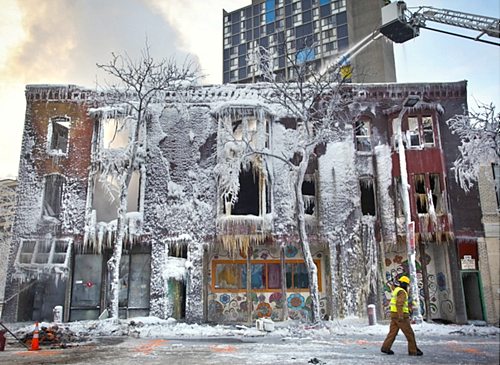
II. Explosions
by Seneca III
Caveat: It must be emphasised that this analysis is being carried out only on the basis of some rather inadequate photographs and some snippets of media-reported hearsay evidence from immediate and other witnesses and speculators and, to make things even worse, it is further burdened with the weight of some barely remembered personal experiences long lost on the winds of time.
Consequently any conclusions reached or any suppositions offered by the author must be viewed in the light of these limitations, driven now as they are by a hefty dose of cynicism, and hence the degree of probability accorded them must be calculated very carefully.
However, all conclusions reached and suppositions proposed by you the reader can only be evaluated by you alone now that the forensic evidence has been so completely destroyed; all that you or anybody else has left to work with is that wonderful computer between your ears. Good luck! — Seneca III.
Part IIA — Types, Shockwaves & the Fire
Forward: Other than thermonuclear explosions and extreme curry flatulence — of which the former is obviously a non-starter here — there are three principal types of explosions; those resulting from abruptly ruptured pressure-vessels, gas explosions (which can also be a consequence of pressure-vessel rupture) and high explosives. A brief resume of their shared and individually unique characteristics follows in note/bullet form rather than in the long-winded and formal mathematics of the chemical and physical theories of (rapid) thermal decomposition and gas dynamics, which in this context are not necessary and can be accessed elsewhere by any who so wish.
The physical dynamics of inert gases or liquids escaping from a ruptured pressure-vessel do not need to be addressed here either. Where gas explosions are addressed their immediate source is immaterial, as an understanding of their thermal and pressure dynamics as compared to those of high explosives is the main thrust of this exercise.
(a) Types
- Explosive materials are separated into three types, or categories; those which detonate easily are known as sensitive or primary explosives (see TATP et. Al. in Part III) and, other than TATP, are used mainly in detonators; those that need a bit more energy to detonate such as guncotton and other are often used as primers (boosters between the detonator and main charge, although with modern explosives the tendency is for detonator-main charge direct); those which need quite a lot of energy to detonate are known as insensitive or secondary explosives and are used mainly in warheads and as demolition or cutting charges, many of which can be ignited and will burn, albeit fiercely, uncontained in air. (Do not try this at home!)
- All of the above are (highly) exothermic oxidation reactions where the oxygen available is a critical factor (the oxygen balance is the determining factor in conversion of the heat of explosion into mechanical work) that governs the amount of product gases available for expansion.
- Explosive velocity is increased with smaller particle size (spatial density), increased charge diameter and degree of containment.
- Typical detonation velocities in gases range from 1800 m/s to 3000 m/s and in high explosive solids as high as 10,000 m/s whilst in gels and liquids from 5000-8000 m/s.
(b) Shockwaves
- Explosive velocity, or detonation velocity as it is often known, is the velocity at which the shockwave front travels through a detonated explosive. Explosive velocities always travel faster than the local speed of sound in the material. In a few milliseconds the initial energy is spread out and forms a luminous fireball that expands at the speed of sound in air that has been heated by the explosion and thus it [the shockwave] is travelling faster than in air at standard temperature and pressure. The result is a shockwave at the surface of the fireball which, as the fireball expands compresses and heats the surrounding air which in turn causes the fireball to cool to the point where it is no longer luminous and thereafter the shockwave (of rapidly compressed air) moves outward causing mechanical damage to anything in its path — roughly speaking.
- Typical Failure Pressures of Structural Building Elements Exposed to Gas Explosions
114 mm brick wall 22-35 kPa Unrestrained brick wall 7-15 kPa 100mm themalite block wall 14-22 kPa Double plasterboard 3-5 kPa 50 mm breeze block wall 2-5 kPa Single plasterboard 2-5 kPa Glass windows (firmly anchored) 2-7 kPa Room doors (internal type) 2-3 kPa
Let us proceed:

Frame 1: Schematic of the effect (at a molecular level in this case) of an explosive detonated on or close to a solid surface (see Note 1 and link).
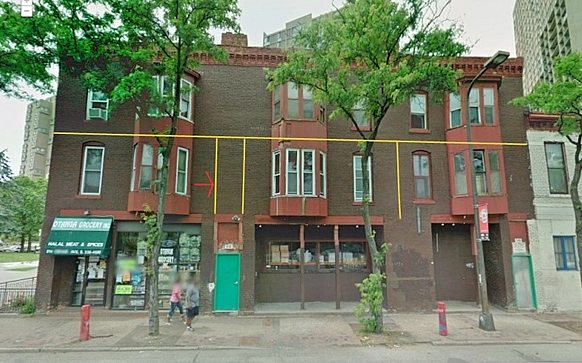
Frame 2: Now we locate the schematic in Frame 1 at the point of the arrow (yellow lines are the estimated positions of partition walls and ceilings)…

Frame 3A: …such that it is superimposed thus on the first partition wall in order to try to visualise the forces at work on the other walls and the ceiling, including reflections which generate a cascade or hammer effect (double arrow, bottom left)…
(c) The Fire
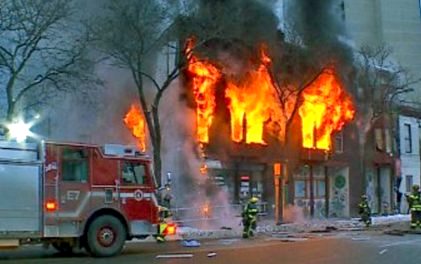
Frame 3B: …We observe the evolution of the subsequent fire from the time of the arrival of the first (?) unit…

Frame 3C: …until it reaches its furthest lateral extent …
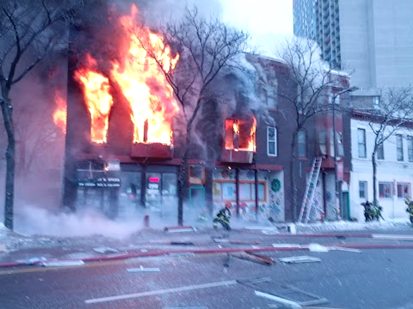
Frame 3D: …and its fiercest intensity at its primary focus and is then gradually…
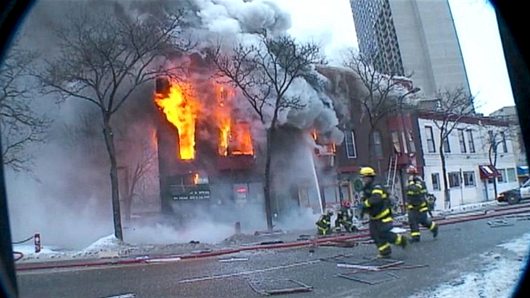
Frame 3E: …extinguished…

Frame 3F: …and, finally, damped down, leaving the classic collapsed-roof shell structure resultant from a major fire.
(d) Domestic gas explosions (examples from UK).
Domestic gas explosions have two primary defining characteristics — a substantial debris field and major pre-combustion (if any) structural damage to external walls and roofs…
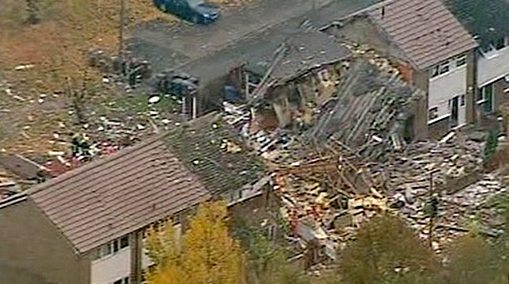
Frame 4A:…
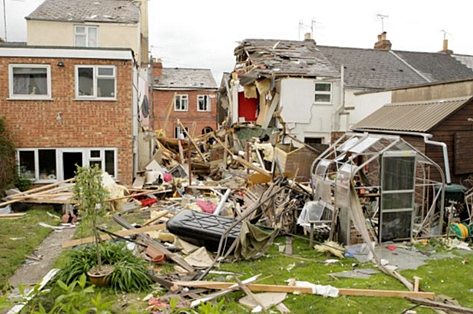
Frame 4B:…
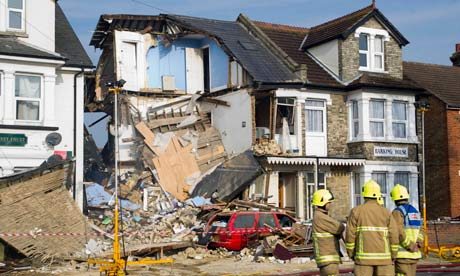
Frame 4C

Frame 4D: …and note here a similar double brick outer wall to that of 514-510 (only newer and hence probably stronger)…
… and, when there is a fire, it takes root after the primary shock wave has caused the major structural damage and projected the debris field outward, as below…
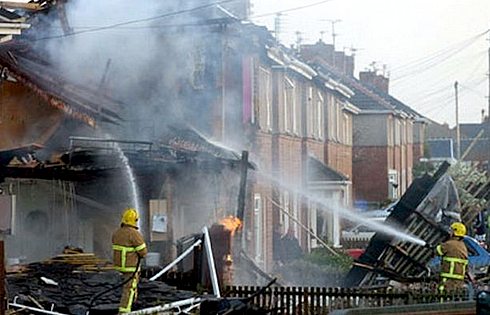
Frame 5A:…
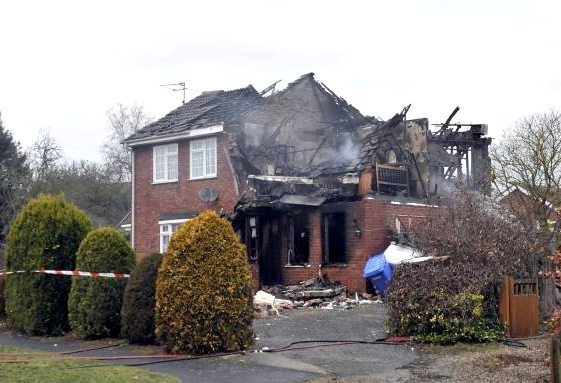
Frame 5B:…
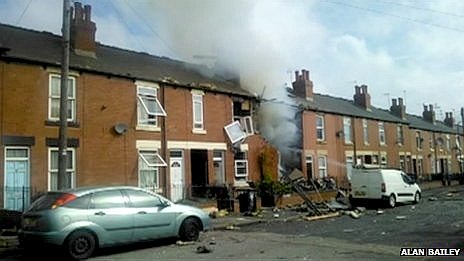
Frame 5C.
… to be continued in Part IIB – Structural Damage & Debris Fields.

Note 1. From experiments carried out (using hydrogen peroxide) at the Lawrence Livermore National Laboratory here.
Previous posts about the explosion and fire in Cedar-Riverside, Minneapolis, on New Year’s Day 2014:
For links to previous essays by Seneca III, see the Seneca III Archives.

There is visible debris on the road in ‘front’ of the structure which remained standing. Perhaps including any additional available photos which provide visuals of the entire structure , such as the post fire aerial image of the Cedar Avenue structure posted in the prior thread should be added for fuller context.
Part IIB
More details post fire via hiiraannet.com
[snip]
[snip]
Additional tidbits:
BBC/Assoc.Press video clip of fire in early stages
KSTP.com video provides few details of victim injuries (ff 1:50)
One of the victims is Achmed Mirer (sp?). The explosion threw him through a third story window right down onto the street. Yesterday we caught up with his boss right outside Hennepin County Medical Center. His name is Osman Ali, owns a [Sanaag Coffee & Restaurant] coffee shop where Mirer works and thinks of Mirer as family and says he is in pretty rough shape.
2:22
Ali telling 5abc/KSTP.com that another of his employees suffered a broken leg.
KARE11.com video report: Firefighters reflect on Cedar Riverside Apartment Fire
via Somalimidnimo.com: “Cedar-Riverside fire survivors recount harrowing moments”
[snip]
Fox video provides actual footage of first responder performing ladder rescue of Cedar Ave. burn victim through window (ff :35)
Minneapolis 3 Alarm Explosion & Fire 1/1/14 With Radio Traffic
Pingback: Work Accidents and Exploding Mosques — Winds Of Jihad By SheikYerMami
Pingback: Fiat Lux — 514-510 Cedar Avenue South, Part IIB | Gates of Vienna
Pingback: Ember Days | Gates of Vienna